Résumé |
Remarks |
>Top 0. Megatrends:
- This report is the 5th installment in the National Intelligence Council' series aimed at providing a framework for thinking about the future.
- We are at a critical juncture in human history, which could lead to widely contrasting futures; the future ins not set in stone, but is malleable.
- By 2020 no country whether US or China, or any other large country will be a hegemonic power.
- In reality the future probably will consist of elements from all the scenarios.
- >Top Megatrends and related tectonic shifts:
- Individual empowerment:
- majority of the world's population will not be impoverished.
- middle classes will the most important social & economic sector.
- small groups will have greater access to lethal and disruptive technologies (precision strike capabilities, cyber, bioterror)
- Diffusion of power:
- Asia will surpass North America and Europe in GDP, population, military spending and technological investment.
- China alone will be larger than US by 2030. India, Brazil, Colombia, Indonesia, Nigeria, South Africa, and Turkey will become important in global economy.
- Europe, Japan, and Russia are likely to continue slow relative declines.
- Demographic patterns: decline in aging countries, urbanization, migration will increase.
- power shift to network and coalitions in a multipolar world.
- global population will reach 8.3B (up from 7.1B in 2012)
- Urbanization: nearly 60% or 4.9B in 2030.
- tectonic shift: aging in the West and increasing in most developing countries; cross-border issue and growing urbanization.
- Food, water, energy nexus: demand will grow in global population
- demand will grown 35-50% owing to an increase in global population.
- climate change: wet areas getting wetter and dry areas becoming more (ME, N-Africa, West-Central Asia, S-Europe, S-Africa, & US SW; nearly half of the world population experience sever water stress. China and India are also vulnerable.
- US regained the world largest natural gas produce and expanded life from 30 to 100 years due to hydraulic fracturing technology.
- >Top Game-changers: potential Black swans - discrete events:
- Global economy:
- Crisis-prone global economy: increased volatility will result in a global breakdown and collapse or whether the development of multiple growth centers will lead to resiliency?
- a return to pre-2008 growth rates looks unlikely.
- across G7 countries, total nonfinancial debt has double since 1980 to 300% of GDP.
- recession involving financial crises tend to be deeper and require recoveries twice as long. 1930's Great Depression hit when many Western populations were relatively youthful, providing demographic bonus during the postwar economic boom.
- Greek exit from Euro zone could cause 8 times the collateral damage of Lehman Bros.
- China will contribute 1/3 of global growth by 2025; for infrastructure, housing, consumer goods, and new plants; resulting in upward pressure on long-term interest rates.
- Governance:
- Governance gap: adapt fast enough to harness change?
- Chinese democratization could constitute an immense wave, increasing pressure for change on other authoritarian states.
- new communications technologies will become a double-edged sward for governance.
- Western dominance such as UN Security Council, World Bank, and IMF will have been transformed by 2030 in line with new economic players. (G20 rather than G7/G8)
- Conflict:
- Potential for increased conflict: rapid changes in power lead more conflicts?
- Intrastate conflicts gradually increase; Kurds in Turkey, Shia in Lebanon, and Pattani Muslims in southern Thailand.
- Afghanistan, Bangladesh, Pakistan, and Somalia have faltering governance.
- Potential for increased proliferation, risk are growing in South Asia and ME would risk inclusion of a nuclear deterrent.
- >Top Regional instability:
- Wider scope of regional instability: ME, South Asia spill over global insecurity?
- ME and S-Asia are most likely to rigger broader instability.
- if Iran develop nuclear weapons, ME will face a highly unstable future.
- Breakthrough agreement to resolve Israeli Palestinian conflict could have positive consequences.
- Challenges to governance in Pakistan and Afghanistan.
- India will be challenged to find jobs for large youth. Inequality lack of infrastructure, and education deficiencies are key weaknesses in India.
- growing Chinese nationalism, and possible question about US remaining in the region will increase insecurities.
- Russia which fails to build a more diversified economy and more liberal domestic order could increasingly pose a regional threat.
- Latin America and Sub-Saharan Africa will remain vulnerable to state failure through 2030.
- Technology:
- Impact of new technologies: can solve growing world population, urbanization, climate change?
- Fear of the growth of an Orwellian surveillance state may lead citizens to pressure their governments to restrict big data systems.
- New manufacturing and automation technologies: 3D printing and robotics have the potential to change work patterns.
- Key technologies; modified crops, precision agriculture, water irrigation, techniques, solar energy, advanced bio-based fuels, and enhanced oil and natural gas extraction.
- new health technology; greatest gains in healthy longevity are likely to occur in developing economies;
- Role of US:
- a big uncertainty: can reinvent the international system?; will remain first amount equals.
- Pax Americana began in 1945 is fast winding down.
- fall of the dollar as the global reserve currency and substitution by another or a basket of currencies would be the sharpest indications of US global economic position.
- key multilateral institutions such as UN, IMF, and World Bank.
- Potential worlds:
- Stalled engines: US draws inward and globalization stalls?
- the most plausible worst case; breakdown of globalization due to a large sale conflict on the order of WWI or WWII.
- But, unlike in the interwar period, undoing economic interdependence would seem to be harder in this more advanced technological age with ubiquitous connections.
- Fusion: US & China can collaborate on a range of issues?
- the most plausible best case; China, US and Europe find other issues to collaborate on more broadly leading to worldwide cooperation to deal with global challenges.
- >Top Gini out of the bottle: inequalities within countries increase social tensions?
- economic performance leads to non-stellar global growth, far below that in our Fusion scenario, but no as bad as in Stalled Engines.
- This is a world of extremes. Within many countries, inequalities dominate.
- US no longer tries to play global policeman on every security threat.
- Cities in China's coastal zone continue to thrive, but inequalities increase and split the Party.
- Non state world:
- non state actors (NGOs, multinational businesses, academic institutions, and wealthy individuals, and megacities) take the lead in confronting global challenge?
- Nation-states does not disappear, but countries increasingly organize hybrid coalitions of state and non state actors which shift depending on the issue.
|
0. メガトレンド:
- メガトレンドの諸要因
- 個人のエンパワーメント
- 多極化
- 人口動態
- 食水エネ資源争奪
- テクトニックシフト
|
>Top 1. Individual empowerment:
- Individual empowerment:
- it is both cause and effect of most other trends including the expanding global economy, rapid growth of developing countries, and widespread of new communications and manufacturing technologies.
- On the one hand, individuals and small groups will have greater access to lethal and disruptive technologies.
- The growth of the middle class constitutes a tectonic shift; for the first time, a majority of the world's population will not be impoverished.
- >Top An expanding global middle class:
- Middle classes in the developing world are to expand in terms of absolute numbers and the presentation during next 15-20 years.
- the global middle class reaching 3B people by 2030.
- the value of $12K GDP per capita is considered to be the level above which democracies do not revert to authoritarian system.
- Increase entry of women in the workplace will be a key driver of success, boosting economic productivity and mitigating the impacts of aging.
- Participation of women in parliament and senior government positions correlates stronger with lower corruption.
- Nationalism:
- is another force that is likely to intensify particularly in regions such as East Asia - where there re unresolved territorial disputes.
- moreover may developing and fragile stats such as in Sub-Saharan Africa face increasing strains from resource constraints and climate change.
- immigrants to cities mostly Muslims in Europe and Russia are coalescing along religious lines.
|
1. 個人のエンパワーメント:
- Share of global middle-class consumption:
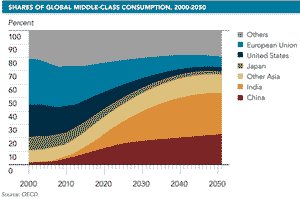
|
>Top 2. Diffusion of power:
- Aggregate power of developing states:
- new multi-component global power index forecast;
- adopted new global power index; including health, education and governance.
- China & India shares increase, but at a lower pace than projected by the other index.
- EU-27 ranks much closer to US.
- the aggregate power of developing states overtakes that of all developing states including US by 2030.
- EU, Japan, and less so Russia decrease shares.
- By 2030, no country will be a hegemonic power.
- networks will constrain policy makers because multiple players will be able to block policy makers' actions at numerous points.
- >Top 'Next Eleven': by Goldman Sachs:
- Bangladesh, Egypt, Indonesia, Iran, Mexico, Nigeria, Pakistan, The Philippines, South Korea, Turkey, and Vietnam
- Indica could be the rising economic powerhouse;
- Chinese total working-age population; will peak in 2015 and decline from 994M to 961M in 2030.
- More fundamental shift:
- The shift in national power is only half the story; enabled by ICT, power will shift more toward multifaceted and amorphous networks composed of state and non state actors.
|
2. 力の分散:
- New multicomponent global power index forecast:
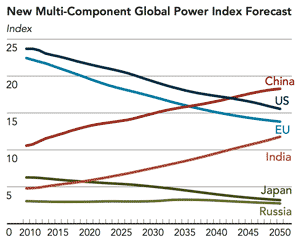
|
>Top 3. Demographic patterns:
- Growing global population: from 7.1B/2012 to 8.3B/ 2030.
- Serious global demographic trends: 1) aging both in West and most developing countries, 2) shrinking number of youth, 3) growing urbanization.
- OECD countries: median age will reach 37.9/2010 to 42.8 years by 2030
- large proportion of seniors face a decline in economic productivity and slower GDP growth or stagnation.
- need to pay closer attention to creating sustainable pension and health care programs.
- Demographic window of opportunity:
US demographers: window of opportunity can be estimated by identifying those years in which the proportion of children (0-14) is less than 30%, and the proportion of seniors (65 and older) is less than 15%.
-
| |
Median age 2010 |
Median age 2030 |
Demographic window |
| UK |
40 |
42 |
before 1950 - 1990 |
| Germany |
44 |
49 |
before 1950 - 1990 |
| Japan |
45 |
52 |
1965 -1995 |
Russia |
39 |
44 |
1950 - 2015 |
| US |
37 |
39 |
1970 - 2015 |
| China |
35 |
43 |
1990 - 2025 |
| Brazil |
29 |
35 |
2000 - 2030 |
| Iran |
26 |
37 |
2005 -2040 |
| India |
26 |
32 |
2015 -2050 |
- >Top Demographic bonus will have faded; though invested heavily in human capital may prolong that bonus. However need to pay to create sustainable pension and health care programs.
- 80% of armed civil and ethnic conflicts have originated with youthful populations.
- Only 6 OECD countries (Czech, Slovak, Finland, Hungary, Poland, and Japan) is the current level of immigration inefficient to compensate workforce.
- migration will be cross-border issue.
- >Top Migration is relatively unregulated by international cooperation.
- growing urbanization.
- expanding middle class and swelling urban populations will increase pressure on critical resources particularly food and water but shortages are not inevitable.
- Age and income disparities create a paradox:
- One would normally expect fast-growing economies to attract migrant labor, not to send it.
- Brain drain; However where economic growth enable more young people to acquire the knowledge; many will choose to migrate to richer countries.
- World Bank estimates; 3% increase of migrants by 2025 would lead to 0.6% increase in global income, $368B, more than the gains from removing all remaining barriers to free trade.
- Rapid urbanization:
- Urban construction for housing, office space, and transport over the next 40 years could equal to the all construction to date in world history.
|
3. 人口動態:
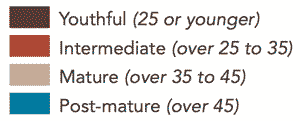
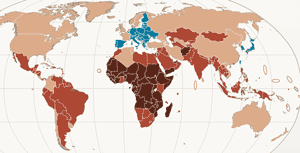
|
>Top 4. Growing food, water and energy nexus:
- Foreign direct investments by state-owned enterprises have focused on mining, quarrying, and petroleum.
- Agriculture; highly dependent on water sources as well as energy-rich fertilizers.
- The world is already farming its most productive land.
- High growth in SE Asia is account for 2/3 of the increase in fertilizer during the next five years.
- Technological improvements have accounted 78% of the increase in crop production between 1961 and 1999.
- >Top Wheat rust problem; due to lesser biological diversity of wheat. The Green Revolution could make wheat rust a greater threat.
- FDI largely focused on mining quarrying, and petroleum.
- Energy Problem:
- Demand will rise about 50% over the next 15-20 years due to growth in the development world.
- Recent optimism; much of the increase production derives from unconventional oil and gas developed in North America;
- Preliminary estimates for 2020; 5-15 M bbl/d as low as $44-68 /bbl. By 2020 US could emerge as a major energy exporter.
- Environmental impact; poor well construction and cementing, wastewater management, methane emission entering drinking water, seismic inducement, and other environmental concerns.
- Oil shale: new technology of horizontal drilling & hydraulic fracturing;
- in fracking well operators pump a fluid (usually water, a million gallon) mixed with propping agent (usually sand, 5M pounds) and chemical additives to control viscosity, pH, surface tension, and scale prevention at high pressure into a well bore.
- China has more reserved of nonconventional gas; double of US reserves; but lacks equipment, experience, and mainly water.
- EU leaders are uncertain about the geology; France has banned hydraulic fracking.
- Sustainable energy: by IEA
- share of renewable rises just 4% during 2007-2050; hydropower accounts for majority of renewables; with wind and solar energy contributing 5 and 2% in 2050 respectively.
- IEA's blue scenario by 2050; 12-25% in solar and 12-22 for wind, depending on desired drop in CO2 emissions.
|
4. 食料水エネルギー問題:
|
>Top 5. Crisis-prone global economy:
- >Top The 2008 financial and its long tail raise the prospect of an extended crisis; the recent slow or stagnating growth driven by de-leveraging (paying down debt)
- McKinsey Global Institutes studies; Total debt has actually grown for most major Western economics with the exception of US, Australia and South Korea, concluding that his pattern is like to continue. "No single country to revive growth."
- Drastic measures will be necessary to check the rapid growth of current liability of governments and reduce adverse consequences for long-term growth.
- Most of the leading Western countries could suffer the consequences of low economic growth that lasts longer than a decade; the key structural challenge - aging - underlying this negative economic outlook.
- Japan7S rapidly aging and swindling population is putting the society in a severely undercutting its long-term growth potential; one elderly person per two working-age people by 2025.
- In Germany the population ages 15-65 will decline fro 54M to 47M between 2010-2030, while in Japan 81.5M to 68.7M.
- Previous economic crises, such as 1930's Great Depression, when populations were youthful; providing demographic bonus during the postwar economic boom.
- The developing world provides more than 50% of global growth and 40% of global investment. Its contribution to global investment growth is more than 70%.
- China's contribution is now 1.5 times the size of US contribution.
- >Top Market share of financial assets by 2020 (→Figure):
- The health of the global economy will be increasingly linked to how well the developing world does.
- Chinese work force: share of aged 15-29, now over 30% will fall to about 21% by 2030.
- India by contrast will remain a relatively youthful country.
- Japan and HK will be just 15% of 15-29 population)
- China will also need to develop agricultural sector through establishment of fair and equitable land rights, and build a banking sector that is more market-based and not geared to favor state-owned enterprises.
- In the net 20 years, Chinese firms will need to go outside China to obtain the next level of technological and managerial innovation, engaging in foreign direct investment in other countries.
- Chinese slower growth - still twice the US average - will ensure that China surpasses US in overall economic size during the next decade.
- >Top The current institutional framework; is not likely to withstand the unleashing a major conflict between the big economic players.
- Western dominance in global structures such as UNSC, World Bank, and IMF, which will be transformed by 2030.
- Brazil and India are not permanent UNSC members; China has a veto in UNSC, but not IMF voting rights commensurate with its economic power.
|
5. グローバル経済への危機:
- 世界の金融資産(2020):
Emerging markets's share of financial assest by 2020:
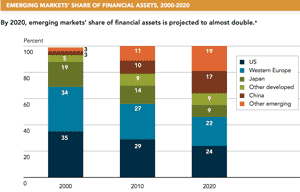
|
>Top 6. The governance gap:
- 'Democratic surplus'; when a country's level of democratization is more advanced than its level of development.
- 'Democratic deficit' is said to exist when a country's development level is more advanced than its level of governance.
- many of ME and Central Asia countries and Asian countries such as China and Vietnam.
- Chinese GDP per capita (PPP) passes the threshold of US$15K, a trigger for democratization; often accompanied by political and social disruptions.
- >Top New technologies shifting roles of citizen and state:
- Cloud architecture; mobile devices; cheap digital storage; Bot (Web Robots)
- Newly empowered citizens will demand equality, open access, transparency, and fairness. authoritarian regimes will face increasing pressures for greater accountability, openness, and citizen participation.
|
6. ガバナンス・ギャップ:
|
>Top 7. Potential for increased conflict:
- Maturing age structures in may developing stats point to the likelihood of continuing declines in conflicts.
- In contrast, the chance of interstate conflict although historically low is rising.
- since 1970s, 80% of all armed civil and ethnic conflicts have originated in countries with youthful age structures.
- Beginning in the early 1990s, there was a marked expansion in size and number for peace support operations (PSOs) deployed in the aftermath of intrastate conflicts.
- the risk will remain high during the next two decades in western, central, and eastern portions of Sub-Saharan Africa; in parts of ME and South Asia; and in several Asian-Pacific island hotspots (Timor Leste, Papua New Guinea, Philippines, and Solomon Islands.)
- If US is unwilling or less able to serve as a global security provider by 2030, the world will be less-stable.
- Spreading lethal technologies:
- Precision guided weapons; access to precision navigation GPS data. Long-range precision weapons and antiship missile systems would pose significant challenges. Precision also may give attackers a false sense of their abilities to tailor attacks to create specific, narrow effects.
- Cyberweapons; self-replicating programs that require human action to spread, worms that can spread without human action, Trojan horses hidden within a legitimate program, denial-of-service attacks, bombarding servers with message to make them crash, and phishing (rogue emails and websites that rick people into revealing password information.)
- Challenger of future wars:
- Access vs. anti-access;
- Nuclear disfavor vs. nuclear renaissance;
- Information superiority vs. information denial;
- regular vs. irregular forms of combat;
|
7. 紛争増大の可能性:
|
>Top 8. Wider scope of regional instability:
- ME and South Asia are the two region most likely to trigger broader instability.
- Will political Islam moderate as it assume power?
- Will governments in transition prevent civil strife?
- Can ME countries fix their economies and ride the globalization wave?
- How will Iran project regional power?
- East Asia; multiple strategic futures:
- Economic growth and interdependence have not diminished Asians' grievances, as seen in the difficult relations today between Japan-China, Japan-Korea, China-Korea, India-China and Vietnam-China.
- regional trends will continue to pull countries in two directions.
- Four broad pathways for Asian order:
- a continuation of the present order:
- a balance of power order
- a consolidated regional order
- a Sinocentric order
- Numerous wild cards:
- Should India fail to rise or Japan temper its relative decline, the Sinocentric order become more likely.
- Should US core Asian partners possess less capability or willingness to balance Chinese power, US may need to set up involvement as a counterbalance, risking a direct contest with China.
- Chinese weakness is perhaps the biggest uncertainty; fail to transition to a more sustainable innovation-based economic model; in an extreme case China would collapse with deep divisions between rich coastal area and impoverished interior and also growing separatism of Tibet and Xinjiang.
|
8. 地域不安定要因概観:
|
>Top 9. The impact of new technologies:
- A shift in the technological center of gravity from West to East and South, which has already begun.
- During the next 15-20 years, multinationasl focus on the fast-growing emerging markets like China, India, Brazil and other emeging economy.
- the speed will depnd on the availability of 1) risk capital, 29 rules of law to protect intellectual property rights, 3) desire of being globally competitive.
- Four technology areas; 1) ICT (big data, networks, cloud, smart city including city dashboard monitoring transportion, power, and waer supplies), 2) automation and manufacturing technologies (changing of business model of mass prodution, and robotics), 3) technological breakthrough (vital resource technologies, modified crops, precision agriculture, water irigation techniques, solar energy, bio-based fuesl and enhance oil nad natural gas ntraction) and 4) health technologies (ameliorate debilitating physical and mental conditons and imporve overall well-being).
- Absorption of new technologies; the time needed to proliferate 25% of users
|
9. 新技術のインパクト:
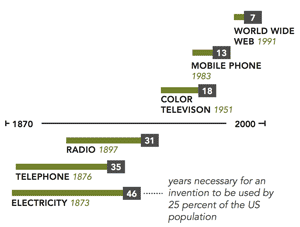
|
- >Top Automation and manufacturing technologies: (自動化・製造技術)
| Technology focus |
Potential for 2030 and issues |
Impact |
| Robotics |
will eliminate human labor; blurring between industrial and service robots; must reduce cost |
total asutomation may become more cost effective than using large levels of labor or outsourcing |
| Remote 6 autonomous vehicles |
- UAV (unmanned aerial vehicle) routinely monitor conflicts, enfore no-fly zones and survey national borders; ensuring operate safely in populateed areas.
|
increase disruption is possible from terrists' use of UAVs. |
| Additive manufactring (CAD, CT, MRI)/ 3D printing |
begiuns to replace some conventional mass-produced products, especially high value products; material quality and cost are limiting factors. |
will benefit from flexibility, speed and customization of additive manufactguring |
|
>Top 10. The role of US:
- US most likely will remain "first among equals" in 2030.
- with the rapid rise of multiple other powers, the "unipolar moment" is over and Pax Americana began in 1945 is fast winding down.
- Four scenarios:
- Stalled engines: US+EU:
- a scenario in which US and Europe turn inward and globalization stalls.
- We don't expect bilateral conflict to ignite a full scale conflagration.
- US political and economic policies and performance drift.
- Greece's exit from Euro zone trigger that rapid, unmanaged exit of the rest of the periphery.
- More nationalist, even nativist, parties rise to claim position of influence.
- In China & India, economic and political reforms remain elusive.
- China's growth falls from 8% to 3% by 2030.
- Fusion: G2
- the most plausible best case; a world in which US and China cooperate, leading to worldwide cooperation on global challenges
- Global economy nearly doubles by 2030 to $132T.
- American dream returns with per capita incomes rising $10K in 10 years.
- Chinese per capita also rapidly increase, ensuring that China avoids the middle-income trap.
- Euro zone crisis proves to be the catalyst for deep political and economic restructuring.
- Rich countries wall themselves off from many developing and poor countries.
- Gini-out-of-the-bottle:
- a world in which economic inequalities dominate; between the haves and have-nots become starker; political and social tensions increase.
- Euro zone core that are globally competitive do well, while others on the periphery are forced out.
- US remains the preeminent power achieving new energy revolution,, technological innovation, prudent fiscal policies.
- However, US no longer tries to play global policeman on every security threat.
- Saudi per capita income declines from $20K today to just $16k by 2030.
- China's coastal zone continue to thrive, but inequalities increase. Fissures appear within China's leadership as members struggle for wealth.
- Nonstate world:
- a scenario in which nonstate actors take the lead in solving global challenges.
- NGOs, multinational businesses, academic institutions, and wealthy individuals, as well as megacities flourish and take the lead in confronting global challenges.
- Countries do not disappear, but orchestrate hybrid coalitions of state and nonstate actors.
- Smaller, mor agile states are apt to be key players.
- Private capital matter more than official development assistance. Social media, mobile communications, and big data are key components.
- This world is more stable and social cohesive than Stalled Engines.
|
10. 米国の役割::
- 4つのシナリオ
- 世界のエンジン失速
- G2蜜月
- コップの中の差別
- 非政府組織の活躍
- 世界のリーダー国(2030)
Elements of power of leading countries in 2030:
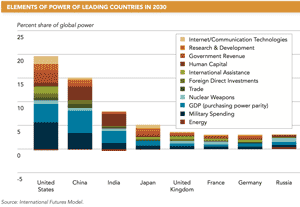
- シナリオ別GDP (2030)の推移
GDP composition in 2030 four senarios:
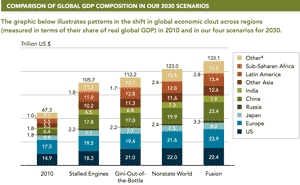
|







